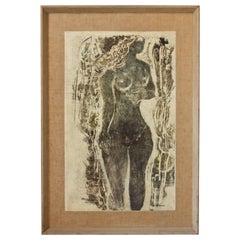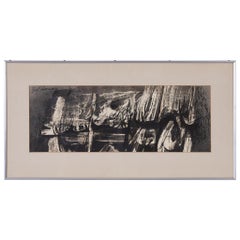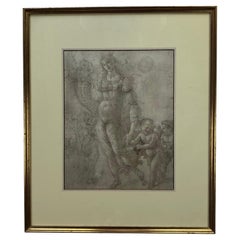Syd Solomon Furniture
American, 1917-2004
The following is from "Syd Solomon: A Retrospective Showing" exhibited at John and Mable Ringling Museum of Art and New York Cultural Center in 1975.
Born Uniontown, PA 1917 Education: Art Institute of Chicago; L'Ecole des Beaux Arts in Paris.
Teaching: Pittsburgh Art Institute; Ringling Museum of Art; Sarasota School of Art; Famous Artists School; New College in Sarasota; Visiting Instructor at University of Illinois in Urbana; Visiting Professor at Roberson Center for the Arts in Binghamton, NY; Visiting Artist at Tampa Bay Art Center.
Awards: Wrote and directed original play "Off Limits", which toured in France, Belgium and Luxembourg during 1945; State Department U.S. Cultural Exchange program to Israel; Ford Foundation Special Purchase Grant for the Guggenheim Musuem.
Exhibitions: Many exhibits from 1944 including Clearwater Museum of Art in Clearwater, FL; Lowe Art Gallery in Coral Gables; Associated American Artists Galleries; Saidenberg Gallery in New York; Midtown Gallery; Trend House Gallery in Florida; Brevard College; Paintings of the Circus at Sarasota Art Association; Annual Exhibition at the American Water Color Society 1955; Fifty Ninth Annual Exhibition at the National Collection of Fine Arts, Smithsonian 1956; Invitational Exhibition at the American Academy of Arts and Letters in 1959; Whitney Museum of American Art in 1964; Colorado Springs Fine Arts Center.
Collections: Adelphi University; Baltimore Museum of Art; Chrysler Art Museum; Guggenheim Museum; High Museum of Art; New Orleans Museum of Art; Wadsworth Museum; Whitney Museum of American Art; Witte Memorial Museum.(Biography provided by Fine Art San Diego)
2
to
2
2
2
2
1
2
2
1
1
1
2
2
6
5,009
4,027
2,457
2,236
Creator: Syd Solomon
"Young Girl" an Early Clay Lithograph by Syd Solomon, 1957
By Syd Solomon
Located in Brooklyn, NY
An early figurative clay lithograph entitled "Young Girl" by lauded 20th century American artist Syd Solomon. Solomon's work helped established Sarasota, FL as a thriving artist's co...
Category
1950s American Vintage Syd Solomon Furniture
“Nightwind” Abstract Ink Drawing by Syd Solomon
By Syd Solomon
Located in Los Angeles, CA
A black and white abstract drawing entitled “Nightwind” by Syd Solomon, c.1964. The piece features expressive movements created by long and harsh strokes and curves of dark ink. A na...
Category
Mid-20th Century American Modern Syd Solomon Furniture
Materials
Paint, Crayon
Related Items
French Neoclassical Drawing Woman with Children Framed by the Medici Society
Located in Miami, FL
A playful neoclassical drawing of a woman with children framed by the Medici Society in London.
Presented in a professional gilt wood frame.
Measures:...
Category
19th Century Antique Syd Solomon Furniture
Materials
Wood, Paper
H 18.5 in W 15.88 in D 0.88 in
Grand-Scaled French Architectural Drawing
By Atelier Garnier
Located in San Francisco, CA
Pencil with wash: a fine and grandly-scaled French architectural drawing of the "Credit Municipal" building; stamped "Atelier Garnier, Lyon
Category
1930s French Vintage Syd Solomon Furniture
Young Girl in Hat Limited Edition Signed Numbered Lithograph by Edna Hibel
By Edna Hibel
Located in Miami Beach, FL
Lithograph print of a young girl wearing a floppy hat by Edna Hibel (American 1917-2014). Signed bottom right "Hibel" in pencil and numbered bottom left "IV 17/18 ed. 343." Matted di...
Category
Late 20th Century Syd Solomon Furniture
Materials
Glass, Wood, Paper
Original Drawing of The Grand Canal, Venice by Robert Hindmarsh Grundy, C.1850
Located in St Annes, Lancashire
A beautiful drawing of The Grand Canal
Fabulous quality.
On wove quality paper/card
Signed on verso.
Unframed
*Robert Hindmarsh Grundy. 1816-1865. Examples of his wor...
Category
1850s English Victorian Antique Syd Solomon Furniture
Materials
Paper
No Reserve
H 7 in W 10 in D 0.07 in
Norman Rockwell “The Young Artist” Framed Lithograph, Signed Artist’s Proof
By Norman Rockwell
Located in San Francisco, CA
A large hand signed and numbered artist’s proof lithograph of “The Young Artist” by Norman Rockwell in original custom frame.
Original oil painting was created for The Saturday Even...
Category
1970s American Vintage Syd Solomon Furniture
Materials
Aluminum
H 39.25 in W 30.25 in D 1 in
Original Landscape Drawing by Leonce Pelletier Dated 1937
Located in Miami, FL
Very well drawn art piece signed Leonce Pelletier, dated 1937.
This landscape art is very subtle and would look great in a contemporary or traditional setting where earth tones are ...
Category
20th Century French Art Deco Syd Solomon Furniture
Materials
Paper
Toms Music Lesson by Edmund Foerster Victorian Lithograph Girls Piano Cat
Located in Dayton, OH
Antique Toms Music Lesson oval painted colored lithograph print by F. Silber for Edmund Foerster & Co. Features two Victorian clad girls / sisters at the p...
Category
Late 19th Century Victorian Antique Syd Solomon Furniture
Materials
Paper
Antique Lithograph of an Arabian Horse
Located in Langweer, NL
Antique print titled 'Cheval Arabe'. Lithograph of an Arabian horse. This print originates from Dictionnaire Universel (..)'. Published circa 1850.
Category
Mid-19th Century Antique Syd Solomon Furniture
Materials
Paper
White Bunny Drawing by Oleg Cassini for Playboy October 1979, Signed
By Oleg Cassini
Located in Brooklyn, NY
White Bunny Drawing by Oleg Cassini for Playboy October 1979, Signed.
Illustration of a woman wearing a white body suit, choker, and hat. Signed by Oleg Cassini. Notice the body suit is in the shape of the head of a bunny with clever use of the 'whiskers'.
Approximate Measurements: Length: 11" Width: 14"
Property from the Collection of Steven Rosengard, Chicago, Illinois
This original drawing was commissioned by Playboy and included in the October 1979 issue of Playboy Magazine (pages 225-227) in a feature that included works from designers such as Bill Blass, Oleg Cassini, Edith Head, Fernando Sanchez, and Monika Tilley, among others, who create their versions of the Playboy bunny costume. Candace Collins can be seen modeling some of the designs in the feature.
Oleg Cassini is an icon of twentieth-century fashion. Though born to Russian aristocracy and raised in Italy, he built a fashion empire that was unmistakably American. Cassini is perhaps best known for the hundreds of designs he created for First Lady Jacqueline Kennedy (see images 4-8), but his achievements as a collector, connoisseur, and quintessential twentieth-century man go far beyond Camelot.
In 1913, Oleg Cassini was born in Paris to the Russian diplomat Count Alexander Loiewski and Countess Marguerite Cassini, a Russian aristocrat of Italian ancestry who also had an interesting link to America. The daughter of Count Arthur Cassini, Russian Ambassador to the United States during the McKinley and Roosevelt administrations, Marguerite dazzled turn-of-the-century Washington as her father’s official hostess and left her mark on the capital city. Stationed in Denmark when the Russian Revolution toppled the czar, Ambassador Cassini and family were exiled to Switzerland before settling in Florence, Italy, where young Oleg was raised. A true Renaissance man, he spoke Russian, French, and Danish before adding Italian and English; he studied medieval and modern European military history and costume and learned to draw; he learned horseback riding, fencing, and the art of chivalry; and, most importantly, he came to understand the struggles of the Russian titled class and other European aristocrats in the wake of the Russian Revolution and World War I.
Countess Cassini started a successful fashion business in Florence, and soon the talented young Oleg was sent to Paris to sketch the latest collections for recreation in Italy. In Rome in his early 20s, Cassini created fashions for high society women and designed for a few films, which planted the seed for his move to Hollywood. The drive to reinvent himself brought Cassini to America in the 1930s; in his autobiography he describes arriving nearly penniless in mid-Depression New York City where his title as an exiled Russian Count meant even less than in war-devastated Europe. Down and out, Cassini struggled for employment, having sketching skills but no knowledge of the wholesale trade required for survival in Manhattan’s Seventh Avenue fashion district. However, he excelled at making connections, and Cassini slowly entered New York society. He was soon joined by younger brother Igor (who had studied in America and travelled with the young Emilio Pucci) and his parents, the once-dazzling Countess and his father, the displaced diplomat still loyal to Russia. The family settled in Washington, D.C., and Igor worked his way up the Hearst newspaper chain to become the famous society columnist Cholly Knickerbocker.
In New York, Oleg Cassini married the troubled socialite Merry Fahrney (who would go on to marry eight times), but the marriage ended in scandal for Oleg, and he decided to follow his original intention and head for Hollywood. Despite initial difficulties, Cassini gained access to Hollywood’s elite (partially through his skills on the tennis court), and was soon hired as a designer at Paramount Pictures alongside the redoubtable Edith Head. In her 1941 film debut I Wanted Wings, Veronica Lake wore a memorable Cassini design. That same year, Cassini met and married the newest young Hollywood star on the scene, the beautiful 20th Century Fox–talent Gene Tierney.
With the outbreak of World War II, Cassini enlisted in the Coast Guard but was transferred to the U.S. Army Cavalry which allowed officers of foreign birth. He attended basic training at Fort Riley, Kansas, and the horsemanship he learned as a boy served him greatly. He attended Officer Candidate School and reached the rank of First Lieutenant (he also became an American citizen at this time, losing his title of Count). Cassini spent several years posted at Fort Riley, where Tierney joined him before he landed a convenient military post in Hollywood. As Tierney’s career thrived (she played the title role in Otto Preminger’s Laura in 1944), she was able to assert her influence over 20th Century Fox’s head Daryl Zanuck, who hired Cassini as designer for Tierney on her 1946 film The Razor’s Edge, which proved to be a brilliant showcase for his talents. The pair separated the same year and, again seeking reinvention, Cassini re-established himself in New York City as a fashion designer. By 1950, the Oleg Cassini label was born.
Combining his knowledge of Old World and modern Europe, Hollywood, the tennis courts of Palm Beach and Newport, and of course, New York City, Oleg Cassini invented a new brand of fashion that was distinctly American and of its moment. For his first collection, Cassini took to the stage, narrating the looks and imbuing the scene with his personality, unusual in an industry where the designers typically remained backstage and the models were called by number over a PA. The first collection was a smash — the president of Lord & Taylor devoted all of their storefront windows to his designs — and by 1955 sales had reached $5,000,000. Oleg Cassini’s career had turned a very positive corner.
Cassini spent the early 1950s traversing the country, personally selling his collections to department stores in the interior, something his predecessors had never done, and moving between the Hollywood and New York scenes. Cassini’s brother Igor coined the term “the Jet Set” for this generation that constantly flew from New York to Los Angeles (then a ten-hour flight), Las Vegas, Paris, Rome, and the Riviera. In 1954, Cassini set out to woo Grace Kelly and sent her roses every day. The two were briefly engaged before her marriage to Prince Rainier of Monaco.
In December 1960, Cassini’s career-defining opportunity came when he was chosen by Jacqueline Kennedy to design her fashions for the White House. Cassini had long known Joe Kennedy and his war-hero son John, and had first met Jacqueline Bouvier before her marriage in the early 1950s. Invited by President-Elect Kennedy to meet Jacqueline at Georgetown Hospital (she had just given birth to son John Jr.) to present to her drawings of potential dresses and First Lady looks, Cassini worked furiously to prepare a new line for the First Lady. Mrs. Kennedy had always had her clothes made by the top French couturiers of the day, but for the White House she wanted an American designer. Cassini wrote in his autobiography that he told the First Lady: “‘You have an opportunity here,’ I said, ‘for an American Versailles.’ She understood completely what I was trying to communicate; she began to talk excitedly about the need to create an entirely new atmosphere at the White House. She wanted it to become the social and intellectual capital of the nation” (Oleg Cassini, In My Own Fashion, 1987, p. 327).
Mrs. Kennedy loved Cassini’s design for a gown to wear to the Inaugural Gala (she had already ordered a dress from Bergdorf’s for the Inaugural Ball), and Cassini was selected as the First Lady’s designer and was soon dubbed the “Secretary of Style.” From 1960 to 1963, Oleg Cassini would design over 300 items for Mrs. Kennedy, creating the “Jackie Look” that contributed not only to a fashion revolution but also the dawn of a new age. Cassini wrote that “Jackie played a very active role in the selection of her clothes. She loved brilliant colors — pistachio, hot pink, yellow, and white among others. Her sense of style was very precise; she would make editorial comments on the sketches I sent her. She always knew exactly what she wanted; her taste was excellent” (Oleg Cassini, In My Own Fashion, 1987, p. 334).
After the Camelot years, Cassini’s business flourished and grew into a major industry; his name appeared on everything from couture to tennis-, sport-, and swimwear, car interiors, housewares, and perfume. He collected beautiful and rare artwork, arms and armor, and antique furniture, and lived the lifestyle projected by his image. From this period onward, Cassini also came to live in important homes. Of his Gothic Gramercy Park townhouse on Manhattan’s 19th Street he would write imaginatively, “I walked into the foyer and immediately fell in love. It was a place unlike any other in New York, a sixteenth-century Dutch house transported brick by brick from Europe by the Wells Fargo family in the early twentieth century. There was a vaulted, twenty-foot ceiling in the living room, leaded windows, elegantly carved wood paneling...
Category
Mid-20th Century Italian Syd Solomon Furniture
Materials
Paper
Paul Aizpiri Lithograph Young Harlequin Portrait, Limited Ed Signed and Numbered
Located in Toledo, OH
Paul Augustin Aizpiri, French (1919-2016) Harlequin portrait of a young boy, very color lithograph, excellent condition, pencil signed limited edition 31/100 on vellum paper. Image s...
Category
Late 20th Century Syd Solomon Furniture
Materials
Paper
H 34 in W 28 in D 6 in
Charcoal Drawing on Blue Paper By William Wardlaw Laing, C.1880
Located in St Annes, Lancashire
Wonderful charcoal portrait of a girl.
By a very good victorian artist, William Wardlaw Laing*
Sitter unknown.
Signed lower left
Presented in an antique bleached tropical hardw...
Category
1870s English Victorian Antique Syd Solomon Furniture
Materials
Paper, Wood
Norman Rockwell "the Young Artist" Hand Signed Original Framed Lithograph
By Norman Rockwell
Located in Dayton, OH
"A large hand signed and numbered lithograph of “The Young Artist” by Norman Rockwell in original custom frame.
Original oil painting was created for The Saturday Evening Post’s June 4...
Category
Late 20th Century American Classical Syd Solomon Furniture
Materials
Paper
Syd Solomon furniture for sale on 1stDibs.
Syd Solomon furniture are available for sale on 1stDibs. These distinctive items are frequently made of paint and are designed with extraordinary care. There are many options to choose from in our collection of Syd Solomon furniture, although gray editions of this piece are particularly popular. Many of the original furniture by Syd Solomon were created in the modern style in united states during the mid-20th century. If you’re looking for additional options, many customers also consider furniture by Robert Freiman, Abraham Walkowitz, and Robert Mapplethorpe. Prices for Syd Solomon furniture can differ depending upon size, time period and other attributes — on 1stDibs, these items begin at $1,800 and can go as high as $6,000, while a piece like these, on average, fetch $3,900.



